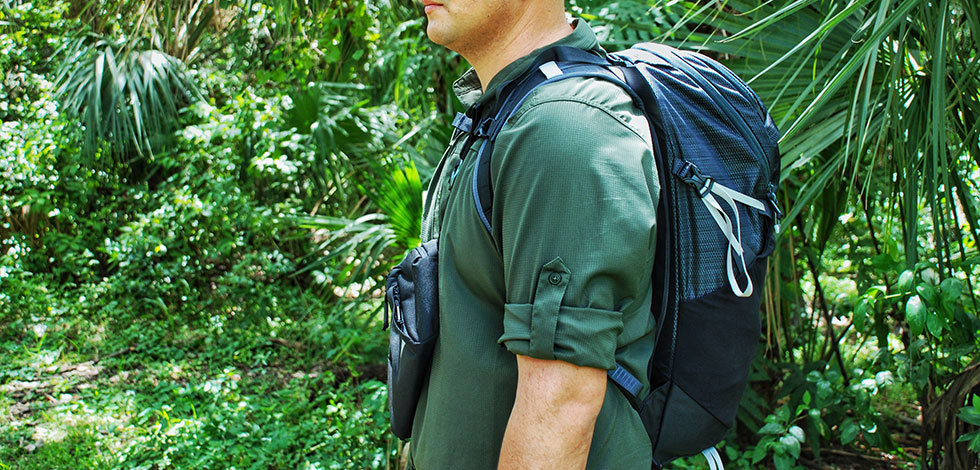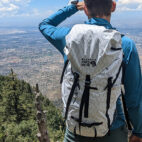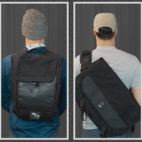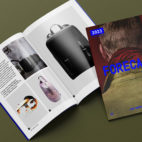First Look: Heimplanet’s Transit Line V2, Motion Series and Commuter Pack
Heimplanet have been in the game now for a decade. And every time they drop something fresh, we’re all ears. So this month we were in for a treat with not one, but three pieces of newness!
But before we dig in, let’s take a few steps back to understand Heimplanet’s journey: after they introduced the Motion Series in 2017, with its rather active and lightweight approach, they wanted to focus on their urban travelers again. Back in 2013 they did the Monolith Series with a set of packs and bags which they pictured to be their Jack of all trades – covering all kinds of travel relevant to Heimplanet. Despite some of them being successful and much appreciated by customers and reviewers alike, they had to learn that a system like this may not be the final solution they hoped it would be. It was not just their first attempt to enter the carry game but also a product design bachelor thesis which may explain the intransigency and bit of a conceptual overload.
The Transit Line was introduced via Kickstarter in 2018, offering a set of items from EDC to one-bag travel. A little less modular and tactical, a little more elegant and specific. During that time Kickstarter was huge, especially in carry. They had really tough competitors launching in the same carry category – more or less at the same time (Peak Design, EVERGOODS and Nomatic… just to name a few). Nevertheless, they managed to get a good amount of money which helped them start production and gained a bit of attention. From there they learned that we are in the year of the Fanny Bag (they named it Sling Pocket) and that some people really like the way they do things.
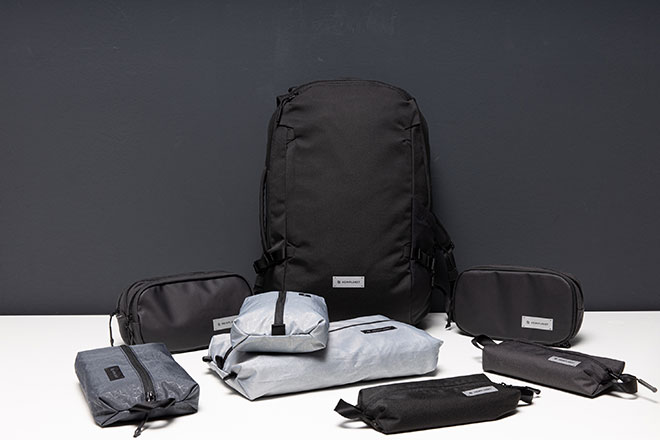
The first production showed them where there was potential for improvements and over the last 2.5 years they collected a lot of feedback. Now it’s the right time to go into the second round, with new versions, general updates and some completely new items.
The Travel Pack always was the centerpiece of the whole line-up. With 34L of max. volume and a back length of about 46cm it’s made to fit a medium-sized male body. While thinking about sizing they realized a rather obvious fact – it is easier to wear a short pack on a long back than the other way around (given that the harness is doing a good job). That’s why they decided to add a smaller/shorter version to their portfolio – the Travel Pack 28. It has the exact same features with a back length of about 43cm. It actually has the same depth but is shorter, to prevent it from bumping on your butt lower back and a little narrower as well. They also modified the harness a tiny bit to make it fit – it still works fine on someone around 190cm and even one of their videographers (203cm!) was pleased with maxed out straps.
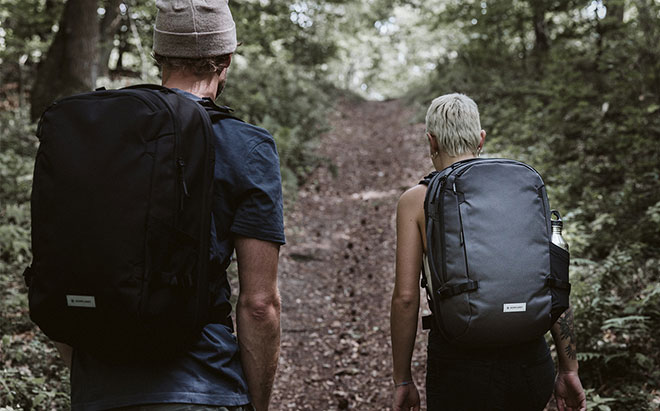
The most surprising item of the initial Transit Line was the Sling Pocket. They didn’t expect it to become the best-selling item, not just within the Transit Line but in general. For that reason it was a rather easy decision to start working on a bigger version, adding the Sling Pocket XL to the line-up. They also updated the branding and some other details according to the rest. You can identify the latest versions by the smaller but brighter logo on the front.
They will keep improving the latest iterations along the way and with every production run but there is one major product missing in the line-up. You can expect them to complete the picture in the next step and do their best to do it properly.
Filling the gap – Carry Essentials
When they started to think about the concept of the Transit Line they took a look at the whole carry universe (past and present) of Heimplanet. And after days of discussions they were able to draw a pretty clear picture. They put the active, lighter series (Motion) on a map, making it one end of their spectrum. The other end was the urban and travel-related line (Transit). Each item takes a bit of its own place within each line but there also was a lot of empty space in between. That was when they realized that there is a need for a new category – which they later called Carry Essentials. It is far less specific than the rest and uses all the knowledge and materials they came across in the other categories. It should work standalone but also in combination with products of other categories.
Following this, they worked on new items but also updated some existing ones which fit the category naturally. The Packing Cubes, the Dopp Kit Better Half, the Simple Pouch and the all-new Kit Bag V2, just to name a few new ones. They are made to work great on their own but also fit nicely inside the Travel Pack.
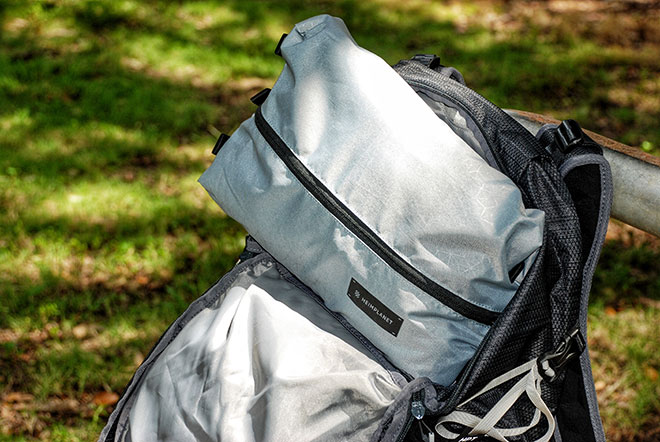
DYECOSHELL fabrics and hardware
Besides the new models they also worked on their materials. They already had their first DYECOSHELL fabrics introduced in 2018 but they saw some potential to further improve them. For Heimplanet, durability is a key feature of sustainability – their goal was to have a long-lasting product with a low initial footprint. Therefore, they kept all yarns dope dyed (solution dyed) to continue what they started in 2018.
A brief excursion about Dope Dyeing
The majority of regular synthetic fabrics are produced from bright undyed yarn (greige/off-white) which’ll be dyed in any specific color after weaving – this process is called piece dyeing. On average this step consumes the most resources producing such a fabric. You massively cut water, energy and chemical consumption (by over 50%) as well as lowering the CO² output about the same at least, by eliminating this step. Dope dyed yarns are extruded from molten pellets like any other synthetic yarn but by adding a highly concentrated colorant to the masterbatch you get a colored yarn right away – without regular dyeing. Sounds too good? Well there are a few obstacles to tackle, like bigger MOQs and higher costs, BUT at the end you get a more sustainable fabric that is as strong as any other new high-quality fabric. It also is extremely UV and color-fading resistant since the color particles are not just on the surface but throughout the whole yarn – that is why this is common practice for any good carpet.
To further improve the fabrics of 2018 they switched from 800D Nylon x 660D Polypropylene to all Nylon. That makes it a tiny bit heavier and more expensive but at the same time it’s a little softer and together with a new finish, also even more durable. Alongside the 800D x 660D Nylon (DYECOSHELL I) they developed a lighter version of it: DYECOSHELL II. It is a 400D x 330D Nylon using the exact same yarn as the original one but as single ply instead of double. It offers a nice mix of classiness and techiness while being pretty lightweight and very abrasion resistant, making it their personal favorite. So far they use it at the bottom of the new Motion Series, the Simple Pouch, the main compartment of the Neck Pouches and the all-new Commuter Pack but you can expect them to use it more often in the future.
In addition to the technical aspects they finally made the all-black version of both fabrics which they already talked about during their Kickstarter but barely missed the stretch goal. You’ll now find most new Transit Line items in Castlerock Gray and Black.
A rather small item albeit a big improvement is their custom hardware named Slitlok which they now have in different sizes. For Heimplanet it’s things like these that make them really like what they’re doing. It represents the very basics of what they feel product design is about. Whenever you encounter a problem that is not solved in a way you are satisfied with or even not solved at all – the challenge begins and Heimplanet describes it as a weird, thirsty mini-me crawling to the surface not caring about costs and deadlines. They wanted to create a general piece of hardware that would allow them to connect webbings to each other in a way that doesn’t look detachable, is strong enough to be used for a shoulder strap and is made from one piece – eliminating small parts that can break and reducing noise while in use. They made many iterations and modified the shape by 1/10th of mm to get it right. The final pieces are made from 6061 Aluminum and are sandblasted before anodizing to boost abrasion resistance. The cherry on top is a small laser-etched logo on each piece. The average tensile strength of the 38mm version is 132.5kg (292lbs) – slightly over-engineered.
In combination with their previously developed G-hook, they now have covered all areas they felt the need to offer their own solution for until they face the next challenge.
They will continue their journey and hope to get through these hard times with just a few dents and scratches – to steadily complete the picture of the brand Heimplanet.
First Look: Motion Series and Commuter Pack
I had the opportunity to get my hands (and eyes) on the updated version of the Motion Arc 20L and the Motion Ellipse 25L and the new Carry Essentials Commuter Pack. Let’s dive into some specifics.
Motion Arc 20L Light & Ellipse 25L Dark
The first thing that catches the eye is the colorways; muted grays with a pop of marine blue, or all-black with a pop of white. Secondly, these packs are feather-light, which is a testament to Heimplanet’s design team – they’re well thought out without being over-engineered. The website says 1.63lbs and 2lbs, respectively, but they feel lighter than that.
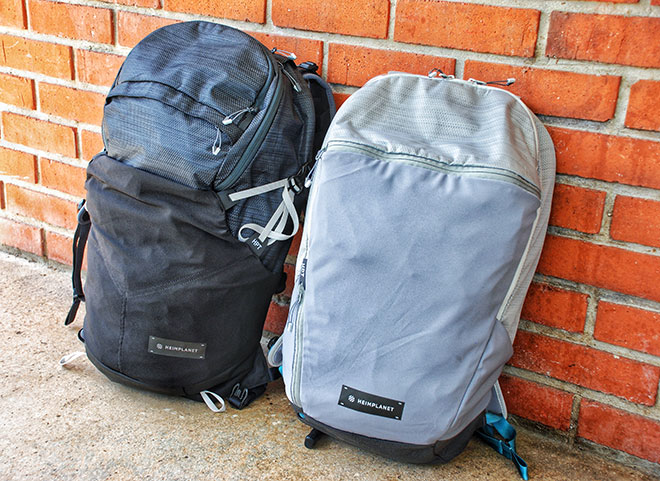
The exterior is made of weather-resistant materials with a reinforced bottom, namely a proprietary 210D Rip-Stop Melange with PEVR lamination, DYECOSHELL II, and a Nylon Spandex. That sounds nice on paper, but how does it feel and perform? The mix of fabrics works well together. The top portion shed water quickly and didn’t soak. The laminated material is surprisingly silent and doesn’t wrinkle, a concern I had when I first saw it. The reinforced bottom is thicker than the rest of the pack but soft to the touch; I found it to be abrasion-resistant and it wipes down clean.
Lastly, the middle section of Nylon Spandex was a risky move that pays off. It has the right amount of give, allowing it to be useful in all sorts of situations, but is attractive whether loaded or empty. It’s great for either storing a few essentials or stuffing a jacket. Both bags implement this material a little differently. Where the Arc uses it as a large pocket in and of itself, the Ellipse has a dual-pocket beaver-tail that’s strapped in on either side of the bag. Both implementations have their pros and cons. Where I like the simplicity of the Arc’s pocket, the Ellipse’s beaver-tail provides two deep water bottle pockets or two pockets for other gear.
The back panel and shoulder straps are comfortable, even under load, featuring a 3D EVA foam in the geometric Cairo Camo pattern Heimplanet is known for. There’s not a ton of padding here, but the padding included does the job well, and that’s because there’s some teamwork happening between the padding, strap width, and a firm frame sheet. This mix allows the bags to be lightweight yet still feel comfortable under load. If it’s not enough, a sternum strap and a hip strap are available to further distribute the weight. The Ellipse, given its larger capacity, includes load lifters!
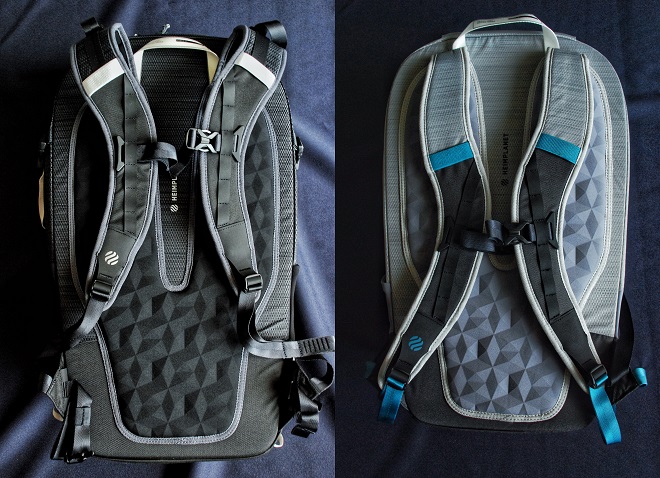
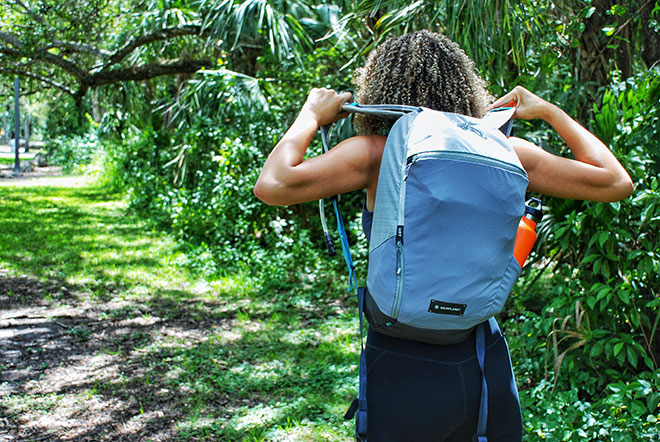
What else? Throughout the bags, there’s what appears to be YKK #5 zips. These zips are super smooth and include generous and easy-to-grab zip pulls. They’re not AquaGuard, but nevertheless provide a measure of water resistance. The water bottle pockets on either bag easily fit my 25oz Hydro Flask. I am a little concerned that the pocket on the Arc may not be as deep as I would like.
As for the insides, where the Arc includes a large front pocket with spandex webbing for expansion, the Ellipse has two medium-sized rip-stop pockets. Both include a cavernous main compartment. Inside the main compartment, there’s a fleece-lined laptop/hydration pocket with a false bottom. I seamlessly placed my 13-inch Surface Book 2 and my Osprey 2.5L bladder inside – not at the same time, though! A buckle with webbing will keep both in place. Above the laptop/hydration pocket is a small essentials pocket. It’s useful when the bag isn’t too packed out, but cumbersome when fully loaded as either the pocket is in the way, or the gear is in the way. When using the Arc, I often opted to use a small exterior side quick-access pocket instead. Further inside, there’s a compression band. At first, I didn’t think I’d find it useful, until I stuffed some loose clothes inside and strapped them in, giving me space for my Peak Design Tech Pouch and gear.
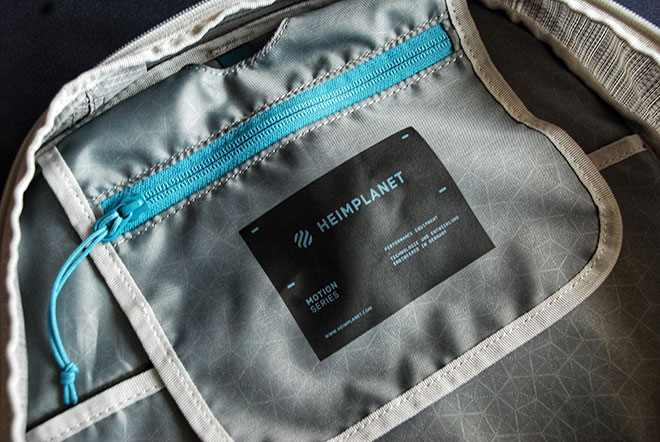
Even at 20L, there’s a lot of space in the Arc, and the domed top affords more room for things. This is especially so on the 25L Ellipse; I could pack enough for a week-long trip in there.
Either bag could easily be a daily driver if the aesthetics fit where you’re going. Still, they’re at home while traveling or on a hike exploring the wild unknown. Both Motion bags are crazy light and fit a lot of stuff, yet have the right mix of padding and straps to make them comfortable. Also, they pack flat!
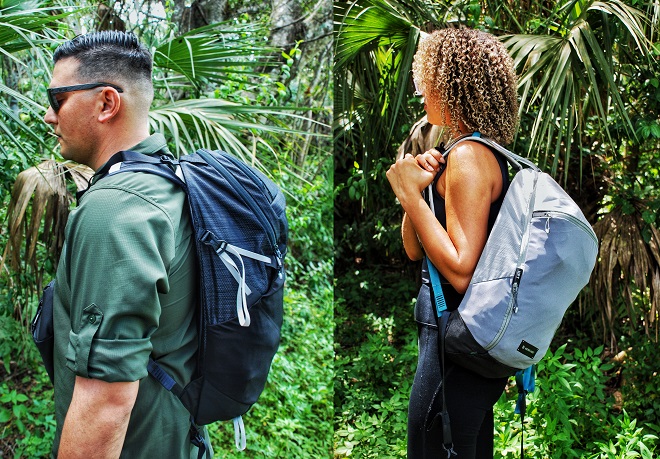
Carry Essentials Commuter Pack
Unlike its wild, outdoorsy cousins, the Commuter is made for the city. It’s your daily driver, the bag you take to work, to the gym, to run errands. The outside is made entirely of DYECOSHELL II. It’s soft to the touch but strong, durable, and abrasion-resistant. During my time in use, I became more appreciative of this fabric. Why? I own an Attitude Supply ATD1 and at one point, an EVERGOODS CHZ22. Both easily attract and show off lint and dust. I’ve been using the Commuter for a few weeks now, and I only had to dust it off once when I placed it down on a dirty floor. Additionally, the fabric just feels pleasant to the touch; it has an understated softness. It’s soft, but not weak. That’s a good thing because the DYECOSHELL is everywhere on this pack, even lining the straps.
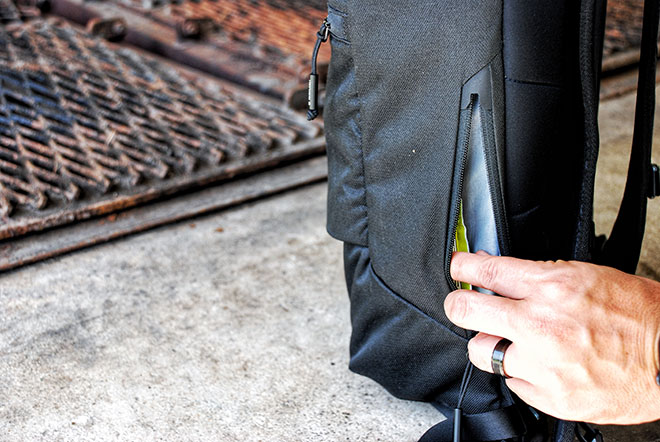
First and foremost, this is a roll-top pack with side access. The roll-top is sealed with a G-hook that feels sturdy. At first, I found the G-hook to be a little cumbersome and thought to myself that it was a deal-breaker. Once I found the proper motion, removing the hook was a breeze and the roll-top became enjoyable. The roll-top includes a magnetic lip that made it easy to close and roll the bag down; it’s a simple yet elegant touch. There’s only the minor annoyance of the magnets closing the pack when I want it to stay open. I’d rather have the magnets than not have them. In use, unfurling the roll can get you about an extra 4 liters of space.
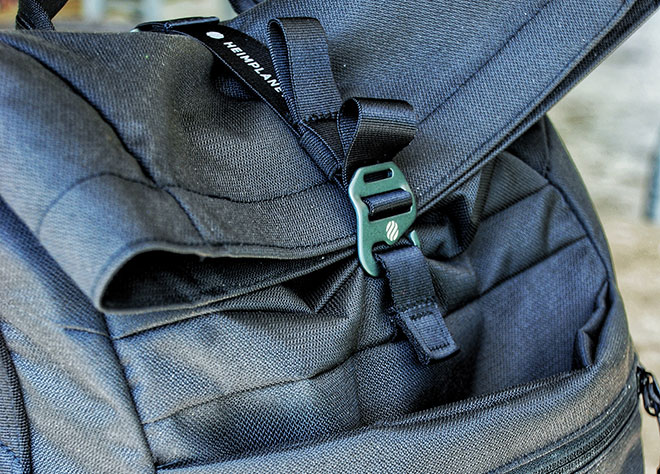
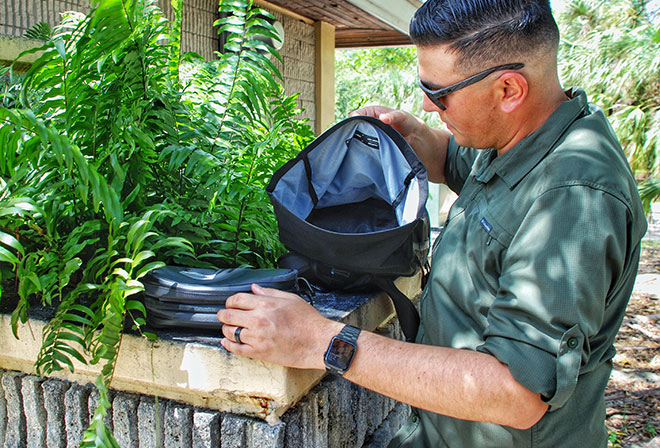
If you’re not a fan of roll-tops, though, the Commuter may not be for you. Although the large side opening gives access to the main compartment, I couldn’t get to my laptop from the side. Each time I went for my device, I’d have to open the roll-top. Personally, I was okay with this as I only remove my laptop once I am settled into where I am going.
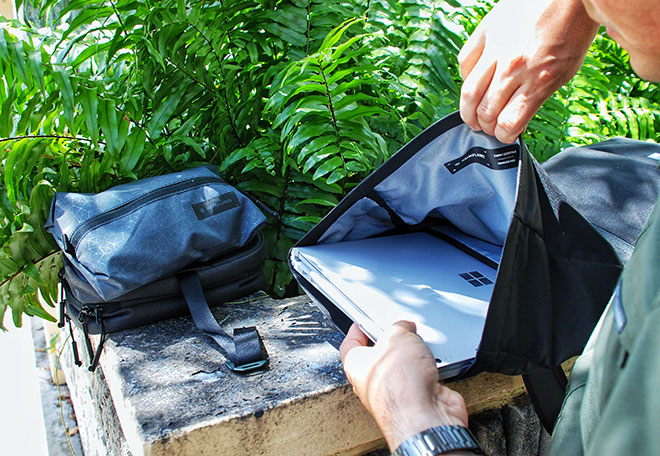
On the outside, there is a top and side handle that make grabbing this bag a breeze. Both handles are lined with the same material as the rest of the bag, meaning it’s a pleasure to handle and feels nice in-hand. In fact, sometimes, it just felt right to carry this pack tote-style.
The back panel seems to feature the same frame sheet as the Arc and Ellipse, while the padding is slightly slimmed down – it’s fine. This pack isn’t meant for long excursions anyway, even though I never felt uncomfortable or overburdened. The geometric design is present, although not as pronounced; even under load, the Commuter was comfortable. The sternum strap comes with a Fidlock buckle, while the hip strap is a standard, albeit cool-looking plastic buckle. Really though, I don’t see the need for a hip strap on a bag this size unless you unfurl the roll-top and stuff it – even then. The shoulder straps are soft and conform to the body; they aren’t as rigid as other straps within the same category. Again, at 19L, a robust harness system isn’t needed. What’s here works; not once did I long for something more substantial.
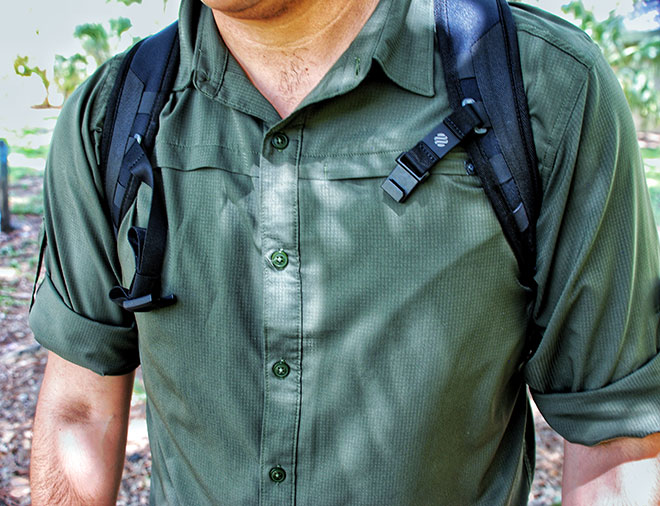
The front of the pack holds a large horizontal quick-access pocket with some organization and a small side pocket. I was curious about the design of the horizontal pocket, as there is a gap between the pocket itself and the main bag. I reached out to the pack’s designer Moritz Grebe to ask him about it, here’s his response: “The “hover” pocket (that’s what we call it) is a combination of thoughts. First of all, we wanted to have a dedicated pocket for small things – always a bit more difficult with roll tops. We also wanted to give it a utilitarian twist without looking too techy, but distinguishable. The gap [between the pocket and main compartment] can be used to store a jacket or your U-lock, for example. By using the G-hook closure of the main compartment, you can secure both and stash/stow the actual item in the “gap.” FYI: The hover pocket is 10mm wider to have it be relaxed even when the pack is pretty full.” It works. Also, the small side pocket was great for grabbing small essentials without taking the pack off.
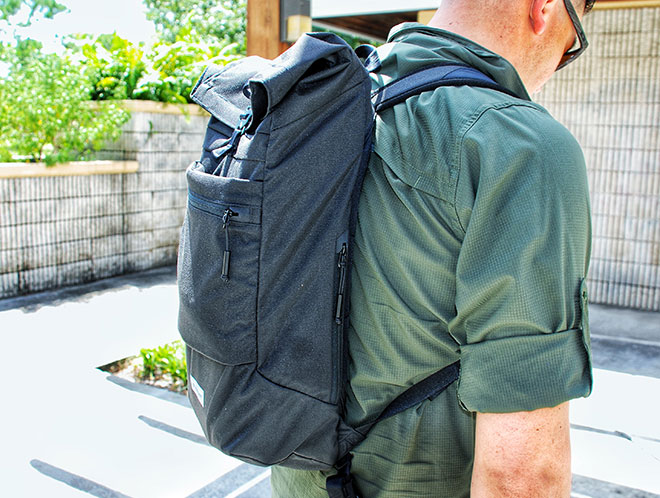
Marketing doesn’t show any pictures of the inside, so here goes. The inside of the Commuter is no frills. It has a false bottom fleece-lined laptop compartment with a Velcro strap, enough to store my 13-inch Surface Book 2. However, I am doubtful anything bigger would fit. The laptop compartment doesn’t stretch, so I sometimes struggled to align my device with the pocket – this could just be that the Surface Book has a weird shape to it. The main compartment is lined in light gray and absurdly big. It’s stated to be 18L, but feels much larger. I can probably carry my kid around in this thing (I won’t, though). I made several grocery runs with the Commuter, picked up packages from Amazon, and went to work with a full gear loadout. In everything I did for several weeks, within reason, there was always room. Also, the side access made retrieving items from the main compartment relatively easy.
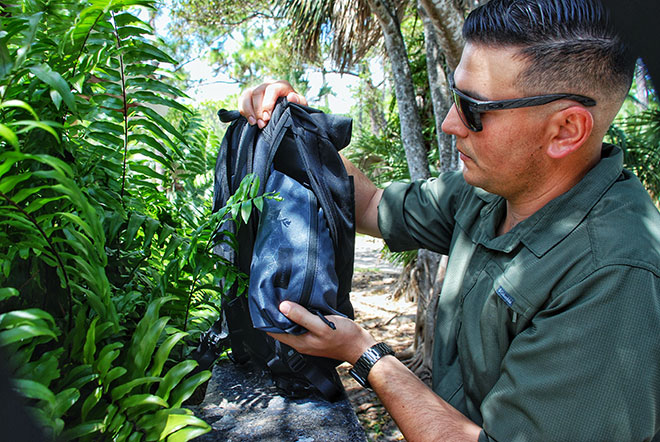
My main complaint was the lack of an external water bottle pocket. I rarely leave the house without a drink. Again, I wanted to understand the reasoning behind this decision, so I asked Moritz. Here’s his response: “Water bottle pockets are always a polarizing topic – some need it, while others don’t care. For a few, it has to be there, otherwise they won’t even consider the pack. But in this case, we feel very comfortable not having one. We wanted the pack to be slick and streamlined for your daily commute with your essential work items. In this scenario, you don’t need your water bottle within reach at all times. The quick-access side zipper to the main compartment lets you skip the roll-top, and if you leave a little room in the pack, you can put your bottle there.” It makes sense. Once I understood the reasoning, the lack of an external water bottle pocket didn’t bother me – I appreciate a bag with clean lines and a streamlined look.
The Commuter Pack is an exciting move by Heimplanet; the entire package as a whole speaks to a high-quality pack.
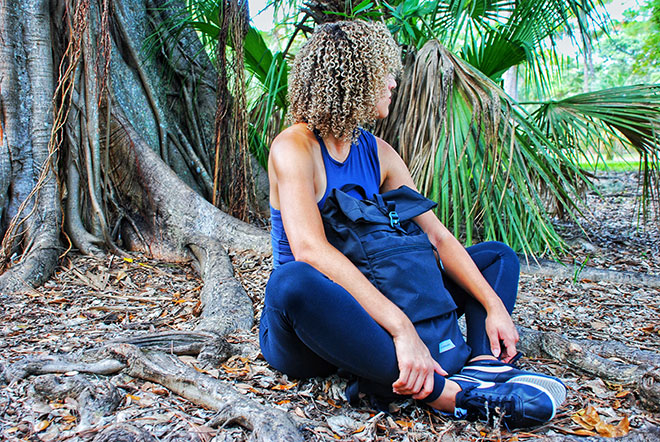
After almost a month of use, I can confidently report that it’s worthy of consideration. It’s a pleasure to handle. It feels comfortable in-hand and on my back. Access is simple enough once you get used to the G-hook, and the side access is big enough to be useful. Additionally, the quick-access pocket does not interfere with the main compartment, even when loaded.
After going through these three bags, I can see the design principles at work here. They’re products that, as Stefan brought out, don’t get in the way; they’re simple and clean – meant to get you where you want to go.
I can’t wait to see what Heimplanet has up its sleeve with their Transit Line and the rest of their Carry Essentials Line.
This article was written by Jovanni Bello. Renaissance man, adventurer and cell phone photographer.





 Carry Awards
Carry Awards Insights
Insights Liking
Liking Projects
Projects Interviews
Interviews
